What Is the Huge Metal Ball Necklace in Martial Arts Called
If someone walks in on you while watching a kung fu movie, they're likely to make a remark something along the lines of "What the hell are you lot watching?" In that location's nothing to justify such a disdainful attitude—boot others in the face while grunting and whooping loudly is a perfectly normal activity for most people, and the delineation of it in cinematic course is as venerable an art equally ballet or professional knife throwing. And really, what sort of person is perplexed by Drunken Master anyhow? That'south, similar, Kung Fu Movie 101 correct there.
The true addict dives much deeper, into the arcane and indecipherable depths of a martial arts celluloid body of water, and comes gasping back up with artifacts so weird, and so unnerving and incomprehensible that fifty-fifty a physician of aberrant psychology might recoil and gaze into the centre distance in tranquility horror. Or just shame you further by making cracks about your questionable taste in movies, assuming information technology's the same person who walked in on you watching Drunken Main in the first place. Any of the following eight movies on this listing is liable to arm-twist either response.
eight. Principal of the Flying Guillotine
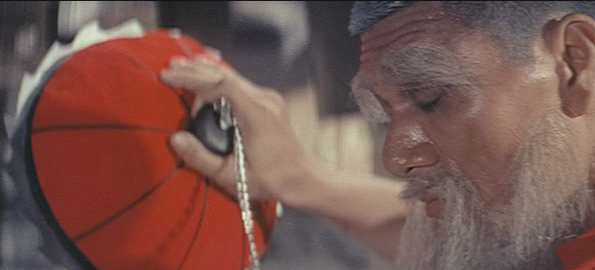
When former Hong Kong activity star (and alleged gangster) Jimmy Wang Yu began working in Taiwan to pick up the pieces of his film career, he spearheaded the production of some…interesting motion pictures. Alongside the fairly loopy Fantasy Mission Force, Master of the Flying Guillotine might be the near unusual of those.
A sequel to Wang Yu'due south One-Armed Boxer, the film opens with the titular character angrily launching out the roof of a thatched hut (even though there's probably a perfectly good door) in gild to take revenge on Wang Yu'south ane-armed kung fu chief, currently busying himself teaching martial arts students to walk on ceilings and walls through the magic of proper breathing technique.
Things just get odder from there. Flashbacks to the previous film tell us that Wang Yu had killed two of the guillotine master's best students, one of whom could inflate himself similar a human hot air balloon (an image borrowed past John Carpenter in Big Trouble In Piffling Mainland china). The evil principal spends part of the run time decapitating random one-armed people with his bladed birdcage-on-a-chain. It's an understandable fault—he's totally bullheaded.
Afterward in the story, the villain employs the help of a samurai, an expert Thai boxer, and a "yogi" who's power of Reed Richards arm-stretching conspicuously influenced the graphic symbol of Dhalsim from the Street Fighter video games. After dispatching these, Wang Yu takes on the villain through the use of kung fu, trip-wire hatchet launchers, and strategically placed bamboo poles.
This film has rightly gone on to become a cult classic, a favorite of Quentin Tarantino's, and echoes of information technology have periodically turned upwardly in popular civilization since its release in 1976.
vii. Taoism Drunk
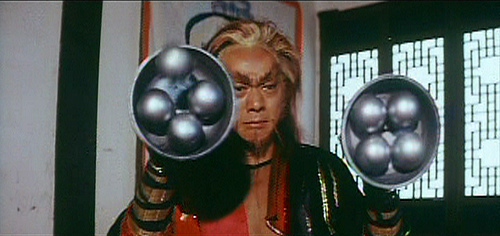
Amidst slapstick routines that make the Three Stooges look stately and restrained, there is a story that involves an alcoholic martial arts principal looking for virginal boys in order to win his brother'southward forgiveness, a chore he undertakes by systematically inspecting children's penises. Information technology's of import to mention he drives a buck-toothed, bamboo Fiat.
The film'due south young protagonist lives with his mom, who trains him in kung fu by running him through an obstacle course that includes Expiry Star compactor walls, a bed of hot coals, and a black embankment brawl monster with feet and a chomping oral cavity full of sharp teeth. What else? How about a caped villain whose weapon of choice is a metal sphere full of flying Phantasm assurance. He had the palms of his hands burned off on a heated playground slide/torture device, then who tin can arraign him if he's a little temperamental?
The fight scenes are fast-paced, visually inventive and tight, just the sort of thing one expects from the slap-up Yuen Woo Ping. None of this makes a whole lot of sense, and it's probably not supposed to.
6. Return of the Bastard Swordsman
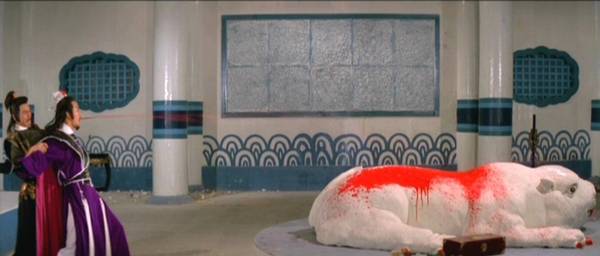
It's pretty common for people in kung fu movies to have superpowers—they fly, dial trees in half, whatever. In that location is a homo in Return of the Bounder Swordsman who has mastered the ability of the silkworm, and he uses that ability to produce silk from his hands at will. Don't laugh—he can spear enemies through the torso with solid shafts of silk, or hurl a massive cocoon at them.
Set confronting this formidable super-pugilist is an evil cult master with the ability to make an opponent'due south heart explode, causing him to vomit blood. For some reason he accomplishes this by repeatedly puffing up his breast like a toad. Only by playing big taiko drums can one hope to counter his attack.
This pic, released by Shaw Brothers in the mid-eighties, is a prime example of what filmmakers can do using merely practical effects, with merely a smattering of ILM-style visuals, particularly during a major fight scene midway through the story. Breakneck one-time school personal gainsay combines with wirework, flying boulders, whirling silken cocoons as big equally an Oldsmobile, and full general magic martial arts craziness to make a viewing feel that is delightful, compelling, and visually ane of a kind.
Although this is a sequel to the Shaw Brothers film Bastard Swordsman, information technology isn't necessary to have seem the first film to thoroughly relish this 1.
v. Chinese Super Ninjas, aka V Element Ninjas
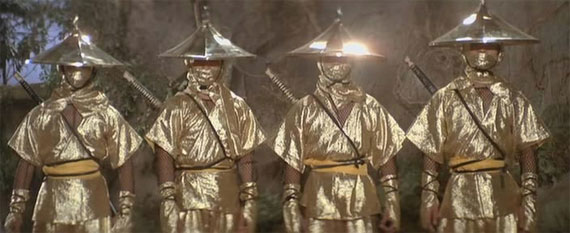
Workaholic director Chang Cheh was probably best known for his seminal ballsy Five Deadly Venoms, where characters have frog, cadger and centipede-based martial arts abilities, but that's far from the weirdest thing he always did.
Chinese Super Ninjas (as it was known in u.s.a.) is a caput-spinning celebration of the garishly bizarre, a story involving a kung fu association that defeats a group of Japanese martial arts experts in what was intended to be a friendly demonstration of skills, but naturally ends upward being a pocket-sized claret bath.
In retaliation, an society of ninjas representing the v elements (water, globe, burn, wood, and gilt) seek revenge on the kung fu experts, nearly wiping out their whole school. The only hope is for the remaining students to seek out a Chinese master of ninjutsu who can teach them the techniques they demand to know to destroy their antagonists.
What sets Super Ninjas apart is its total devotion to fabulous imagery and visual splendor (within the limits of a typical Shaw Brothers budget). The ninjas are wholly fanciful creations, attacking in aureate lamé outfits armed with umbrellas that shoot knives, camouflaging themselves with red smoke bombs and spearing opponents from underground like angry gophers.
The stagey advent of the sets gives one the feeling of watching an especially violent, kaleidoscopic play, performed by actors dressed like members of a seventy'southward funk group.
four. The Seventh Curse
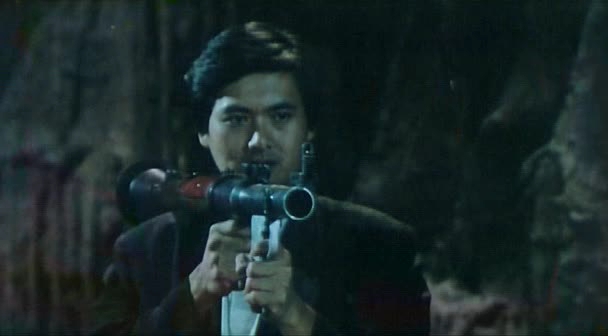
Not a kung fu movie per se, but with enough martial arts lumped in with myriad other elements to give information technology a pass. This is a little bit of everything: kung fu, one-act, sexploitation, shoot 'em up and horror gorefest, with just a piffling bit of Raiders of the Lost Ark and James Bail thrown in for good measure.
A young archeologist travels to southeast Asia and accidentally witnesses a supernatural ritual forbidden to outsiders. As penalization, he is struck with a blood curse that causes bloody boils to explode on the surface of his skin. If this happens seven times, he'll die, so he embarks on a journeying to become the spell reversed, role of which requires him to swing around like Spiderman on a giant Buddha statue while fighting hostile monks, to grapple with a skeleton that knows karate (a funny nod to The 7th Voyage of Sinbad), and avoid existence eviscerated by a flying baby-monster.
It'south hard not to be a little charmed by the nutty, kitchen-sink approach the filmmakers take to this project, fifty-fifty going and so far equally to have the villain crush a bunch of children in a big rock juicer to collect their blood, then later plow into a bat/alien hybrid that Chow Yun Fat, in a cameo every bit a professor of the supernatural, blows up with a bazooka. Great R-rated fun for the whole family unit.
3. Nine Demons
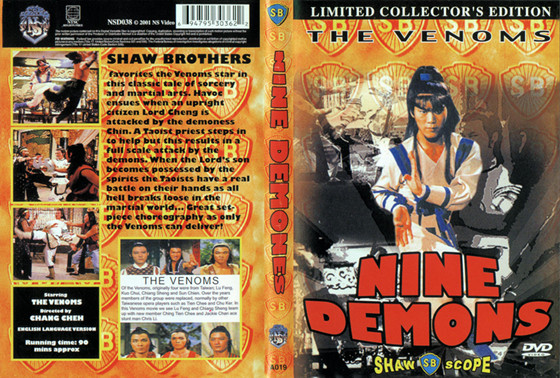
Largely considered to be director Chang Cheh'southward worst film, this is still an immensely fun, completely off-the-wall movie that is difficult to describe to anyone who'due south never taken psychoactive drugs.
Joey (yes, in the English dub there's a Chinese man living during the Ming Dynasty named Joey) falls through a fissure in the earth after a band of thugs murders his main'southward family unit, and meets the Devil, who similar everyone else in the cast is dressed like a 70's-era Vegas magician. He makes a deal with Friction match/Doug Henning that grants him special powers including, just non limited to, a necklace of tiny skulls that transforms into acrobatic vampire children.
These are the movie's near interesting—if very low-budget—visual, accompanied by psychedelic rave lighting and the sort of sound effects one ordinarily associates with a kids' testify about extraterrestrial robots. A swordsman named Roland (over again, this is the Ming Dynasty) tries to stop him, ultimately confronting him with the help of some friends and a magical priest, on the surface of a "pond" that is really but a big soapy puddle on a audio phase the actors are obliged to scoot around on similar iv-year-olds skating beyond a linoleum floor in their socks.
In spite of the WTF premise, it's hard to mistake a movie that tries to do something and then unique, even if it doesn't quite succeed on all points.
two. Encounters of the Spooky Kind, aka Chilling Encounters
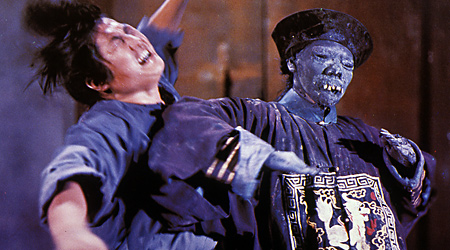
Sammo Hung, Jackie Chan'southward elderberry classmate in the Peking Opera School and the co-founder of the comedic kung fu flick genre, also helped create the genre of martial arts/horror, often featuring traditional Chinese vampires called jiangshi who hop around instead of walk and concur their artillery extended in front of them similar the old Universal Studios Mummy.
Sammo plays a human being whose wife is adulterous on him, and her lover decides to take him bumped off by hiring a sorcerer to con him into spending a dark in a haunted cemetery. There he does battle with a jiangshi under the sorcerer'due south control, fighting information technology with a combination of kung fu, eggs, and dog's blood.
The sorcerer's estranged apprentice tries to help him, culminating in a showdown wherein Sammo and an opponent are compelled to fight while possessed by a series of war gods, and the ii wizards preside over the combat from towers of scaffolding.
Hung, who was manager as well as fight choreographer, puts together some weird, unforgettable set pieces, particularly in the final fight and during a scene where he and a reanimated corpse engage in a skewed recreation of the Marx Brothers mirror gag. Genuinely worth repeat viewing.
one. Riki-Oh: The Story of Ricky
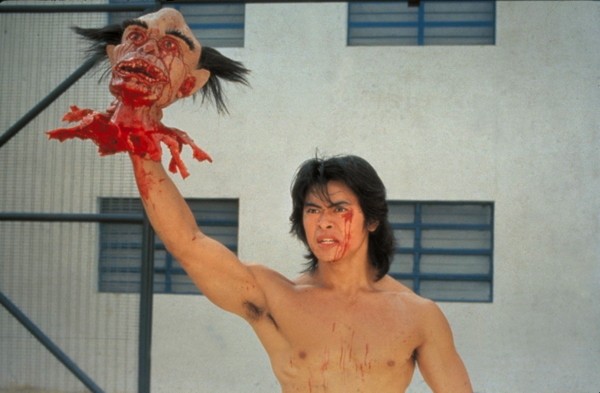
Information technology was probably inevitable that we would come up to this, one of the most outrageous and over-the-peak martial arts movies e'er made.
As ridiculous equally this film is, information technology's likewise strangely prescient: Ricky is sent to a privatized prison in a 1991 version of 2001, which isn't as well far off base from where the actual US prison arrangement is going. All the same, zip else bears fifty-fifty the slightest resemblance to reality.
Ricky, through the apparent power of qigong, is virtually immortal, indelible gunshot wounds, powdered glass to the eyes, and a mouthful of razorblades, among other indignities. Fights include a disemboweled man attempting to strangle Ricky with a length of his own intestine, a humongous thug getting his jaw punched off, and the evil, opium-cultivating prison house warden turning into a demonic Hulk monster in the middle of the final fight, simply to be dumped into a giant meat grinder. The gore is every bit equally disgusting every bit anything in the filmographies of George Romero or Lucio Fulci, but many times funnier.
Riki-Oh is based on a manga, a fact that is most credible in the bizarre scenarios and character designs, which accept a kind of Fist of the North Star flavor. Highly recommended to anyone who likes to express joy while watching someone accept a board with nails in it to the face.
Author Bio: Scot Stonemason lives in Tucson, AZ. He is the author of the blogs Hawaii Timewarp, Eastern Trails, Scotty's Movies North' Tunes, and Tucson Only Kind Of Sucks. He in one case lived in a shack in the eye of an abandoned sugercane field full of giant spiders and rats, because YOLO.
doyleworactagoine.blogspot.com
Source: http://www.tasteofcinema.com/2014/8-strange-kung-fu-movies-you-probably-havent-seen/
0 Response to "What Is the Huge Metal Ball Necklace in Martial Arts Called"
Post a Comment